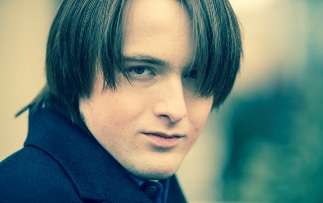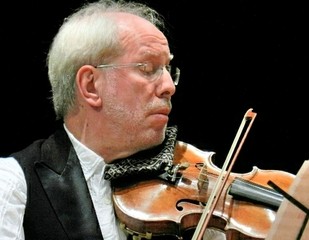|
Back
The Metaphysics of Musical Energy New York
Isaac Stern Auditorium, Carnegie Hall
01/23/2015 -
Wolfgang Amadeus Mozart: Fantasy for Solo Piano, K. 397 – Violin Sonata in E-flat Major, K. 481
Mieczyslaw Weinberg: Violin Sonata No. 5, Opus 53 – Solo Violin Sonata No. 3, Opus 126
Franz Schubert: Fantasy in C Major, D. 934
Gidon Kremer (Violin), Daniil Trifonov (Piano) 
D. Trifonov (© Dario Acosta)
The very first measures of the opening Mozart D Minor Fantasia last night, weighty, almost eccentrically solemn, could have served as a benediction to sanctify the proceeding recital, by two colossi of their instruments.
Not that either Gidon Kremer or Daniil Trifonov needed a blessing from Above. Their own genius, discernment and the mutual iconoclasm of these artists was evidence enough that, with the right performers, even a Carnegie Hall audience almost coughless can be held for more than two hours.
Gidon Kremer has always been the violinist who is not only extraordinary–Herbert Karajan opined the young Kremer was the finest fiddler he had ever heard–but has broken all the rules. The Latvian-born musician champions the Baltic with its own orchestra, he is totally unafraid to program the most daring new music, and his sense of humor (inserting a bars of Beethoven in last night’s simple Mozart encore) is unrelenting.
The good news about Danill Trifonov is that he will be the New York Philharmonic artist-in-residence next year. The better news is that we have already had a chance to hear his dynamic, rich ever-energetic performances three times this month, and each time, it’s as if we were encountering a new artist.
Put the two together and physically, they were like a weird portrait of three generations. The mop-haired, diminutive 23-year-old pianist and the white-haired stately violinist almost three times his age. But musically yesterday evening was a monumental meeting of two monumental minds.
Last night, they played what conventionally is called a “recital”. But so interesting was the combination of Mozart and Schubert with the too rare Mieczyslaw Weinberg, that the rarity was not as important as the revelations, starting with Weinberg himself.
Yes, Alan Gilbert once performed this prolific Polish-Russian composer, who Shostakovich ardently admired, in the colorful Moldavian Rhapsody. But not until one hears, for the first time, the Solo Violin Sonata, one begins to realize Weinberg’s talent.
Not that the solo violin is a rarity. Both Bach and Bartók composed the most complex music for the instrument, and Ysaÿe exhausted its technical resources for the time. Weinberg’s unbroken 22-minute Sonata, within its limitations, gave a colorful, variegated procession of Russian-Jewish tunes, mock-dances, mock-marches, intimations of village festivals, and the most intense music played on the highest ranges of the violin, all making an even more approachable work than the Bartók or Bach.

G. Kremer (© Horst Helmut Schmeck)
This was also a work made for Kremer’s endless depository of sounds from his 1641 Amati. Perhaps superfluously, Kremer had divided the piece into seven sections encompassing “portrait of the father”, “portrait of the mother”, “Flight, running amock” etc etc. Ignoring this was suggested: listening was a greater lesson in satisfactory playing.
Kremer offered movements of non-stop staccato, and a non-stop double-stop cadenza, a combination of endless trills in different ranges, some furious bowing, colors from the flattests harmonics to the most singing arias. And at the end, in what Kremer appropriately labels “Dialogue with Eternity”, he plowed through every kind of timbre without vibrato, without accents, bringing this very great work into that “eternal” transparency.
For those who listened, it was more than Kremer’s musicianship, it was a work of endless melodies, easy to apprehend. The “dissonances” were no more difficult than those of Shostakovich, the melodies I>miraculously leading to the Schubert C Major Fantasy.
The woman sitting next to me had made a prior decision to flick her program pages during the Kremer, with an obvious decision to listen respectfully to the Schubert. Yet the two works were not that far apart. Neither piece had a linear continuity, preferring the pure fantasy of continuous inspiration. Both pieces depended upon endless four-square whistleable melodies–Slavic and Germanic–to set upon their journeys. And both the Weinberg and Schubert gave performers the space to both play and interpret.
Like the opening of the Weinberg, Schubert’s Fantasy started with the simplest measures, but with this the violin rose up from the most glittering measures from the piano. And from here, the duo played music that was both charming and soaring. The series of variations on a Schubert song had Trifonov with his dazzling skating on the keys, both of them finishing with a jaunty final variation. For the rest, Schubert gave us some Hungarian music, a slow Beethoven-like tune, and a Presto finale where both artists sang their way to the rafters.
Schubert obviously took the word “fantasy” literally, and he let go with a non-stop charm, seized upon by the duo of the evening.
Back to Kremer’s favorite, Mieczyslaw Weinberg. It’s easy to say that his music sounds like Shostakovich, but he said it first. “I never took lessons with Dmitri,” he said, “but I count myself as his pupil, his flesh and blood.”
As well as the addition of a Jewish sense of violin, a shtetl sense of rural Jewish folk music, and a personal life which, while grueling, gave him a skin-deep optimism.
The Violin Sonata began with that Jewish tune, but went into a series of dance movements, a Mahler-style mock-march, and a finale of many many different moods. In fact, Weinberg resembles Schubert as much as he does Shostakovich. And am I wrong, or did he begin one movement with the beginning of the Schubert A Minor Sonata finale?
Back to the beginning, that possible hallowing of the concert with the Mozart D Minor Fantasy. Mr. Trifonov played the opening with such gravity–and its ensuing technical challenges with such Lisztian intensity–that one was taken aback at the magnificence of the work as a whole. (Though I wish some enterprising rule-breaker would eliminate that bloodless finishing rondo, which Mozart never finished anyhow.)
That first piece opened up a landscape of other music which did interlink, if ever so subtly with the rest of the concert. Truth be told, though, it was the combination of Trifonov and Kremer which hyperlinked the music.
After that simple Mozart encore with the Beethoven interpolation, the concert ended with a work written by Giya Kancheli for Mr. Kremer. If the rest of the concert had a multitude of secrets peeking from its blatant sounds, Kancheli was the opposite. A humoresque with real humor. A salon piece which never got started. A few violin notes, a few piano notes (sometimes off key and off rhythm). And as usual with Kancheli, the silences were as effective–even in this manifest burlesque–as the notes themselves.
In other words, the concert, commencing with a Mozart exaltation, ended with an enigma. In between was, even in the most solemn moments, the artistic intelligence of Kremer and Trifonov and a virtually metaphysical energy.
Harry Rolnick
|